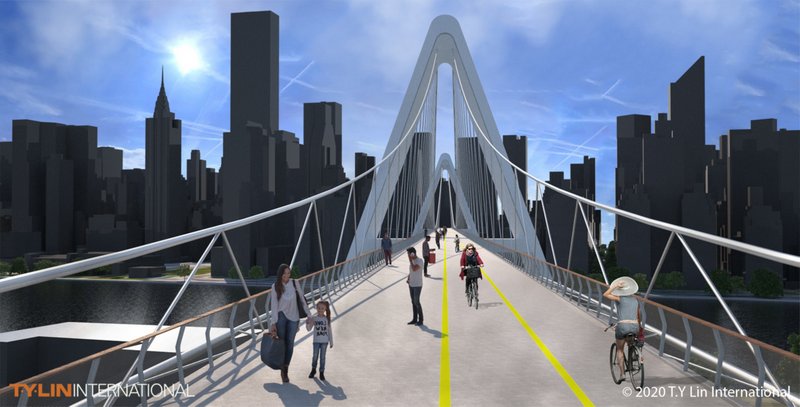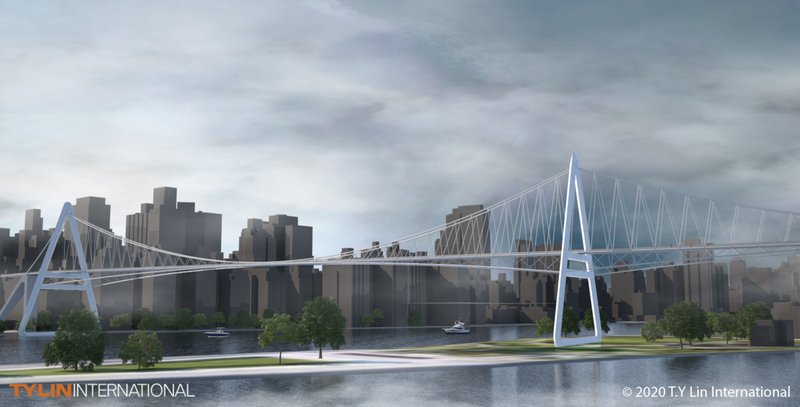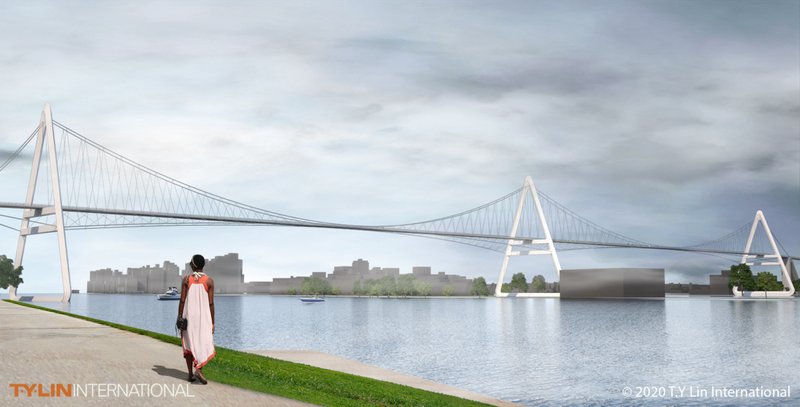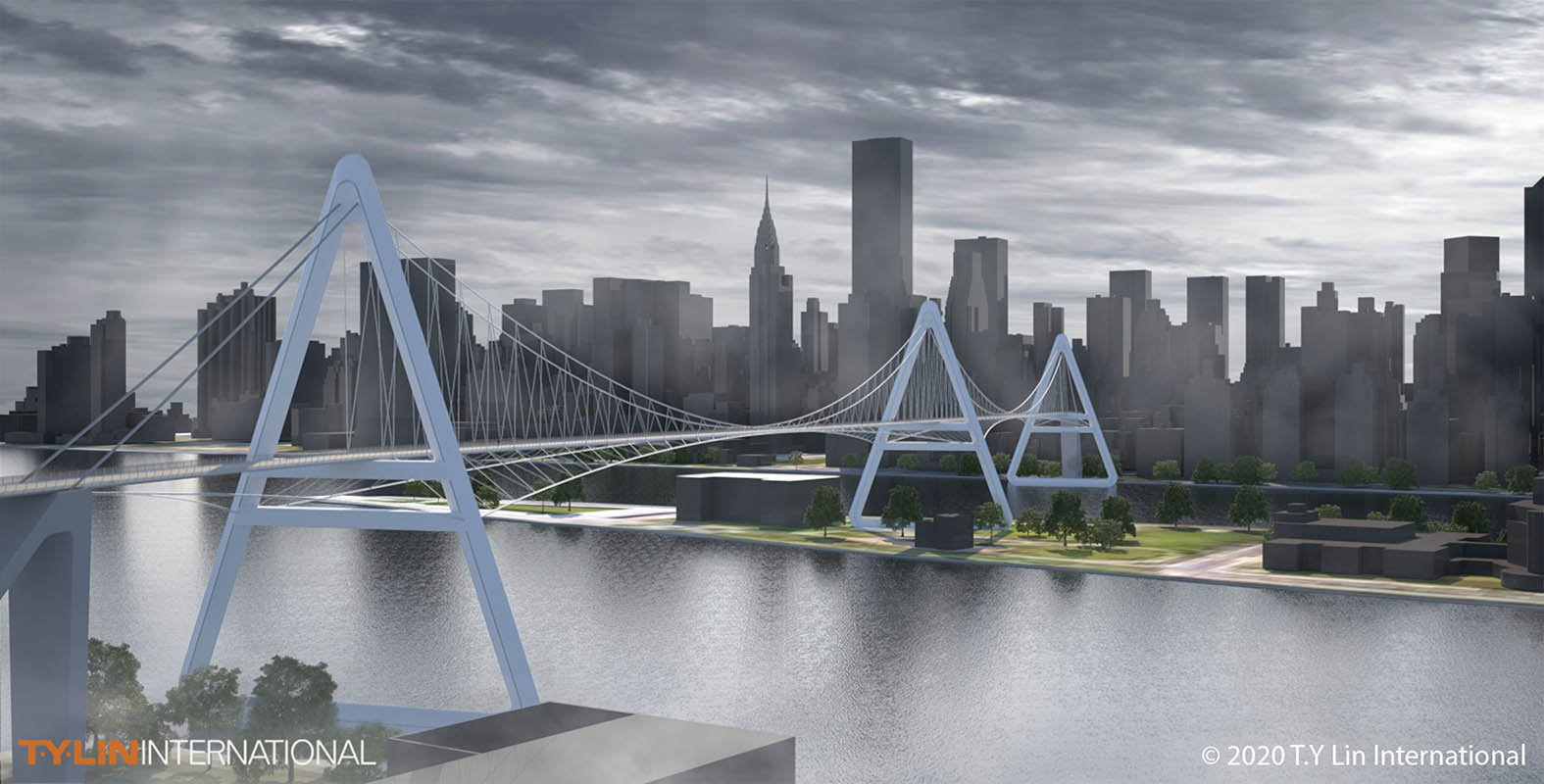A “ribbon bridge” across the East River that will be for bikers and pedestrians only? That’s what’s being proposed by Sam Schwartz, Founder and CEO of Sam Schwartz Engineering, and the former commissioner of the New York City Department of Transportation. “The urban travel mode of the future won’t be flying cars, or robo-cars or even cars. It will be shoes and bikes. Cities can best thrive on these low impact, non-polluting, equitable, and healthy forms of transportation,” Schwartz stated in a press release. Schwartz’s position on the future of transportation is not surprising, given that he is credited with coming up with the term “gridlock.”
Schwartz worked with the NYU Tandon School of Engineering, and T.Y. Lin International to unveil a design for the “Queens Ribbon,” a pedestrian-bicycle bridge that would connect Queens to Manhattan. Cycling over the East River skyrocketed 132% over the last decade, and as the city continues to add hundreds of miles of protected bike lanes, the existing bridges will become more cramped with bikers and pedestrians. The proposed 20-foot-wide bridge would provide safer transit for people commuting and jogging while offering panoramic views of Manhattan and Long Island City. The bridge will also have elevator access to Roosevelt Island and Cornell Tech. It is estimated that each bridge would handle approximately 20,000 people daily, with the three bridges combined carrying the equivalent of 60 packed subway trains or roughly 50,000 cars per day.

The proposed bridge has a preliminary cost estimate of $100 million, potentially a small investment within infrastructure budgets, and considering the amount that could be saved from reduced pollution and traffic. In an interview with Untapped New York, Schwartz explains, “NYC and NYS DOTs plan to spend in excess of $20 billion in their ten-year capital budget. More money should be shifted from cars to pedestrians and bikes. This would be a drop in the bucket when combined with federal dollars. But, developers have shown interest in at least partially funding transportation improvements through value capture so a public-private partnership may be a good way to go.”

The proposed bridge would feature about 10 feet of sidewalk and two five-foot bike lines widthwise. Based on the renderings, it appears the bridge would start on the Manhattan side somewhere around 52nd Street. The bridge consists of a very slender concrete ribbon supported by one vertical and two inclined suspension cables, creating a very light structure. The suspension cables are supported by three delta-shaped towers, each 300 feet tall and 200 feet wide. Schwartz told us that there are many pedestrian bridges in European and Asian cities that served as case studies for his design, including the Millenium Bridge in London, the Helix Bridge in Singapore, and the Passarelle Simon de Beauvoir bridge in Paris. The United States also has a number of footbridges like the 3,000-foot Bob Kerrey Pedestrian Bridge in Omaha, Nebraska.
One leg of the Ribbon Bridge would land in Southpoint Park on Roosevelt Island, just south of the Smallpox Hospital ruin (which is not shown in the rendering but is a protected New York City landmark). On the Queens side, it would land in Long Island City around the location of the failed-Amazon project.

The bridge has received “lots of interest, good media response, [and] a few people want to volunteer to make this happen,” Schwartz told Untapped New York. “The DOT Commissioner and Mayor De Blasio have said nice things but want to review.” If approved, the Queens Ribbon would be the first new bridge built to Manhattan’s Central Business District since 1909. The team is also planning two additional bicycle-pedestrian bridges into Lower Manhattan: one would come from Brooklyn to alleviate space constraints on the Brooklyn Bridge, and another would come from the Hoboken/Jersey City area, the first carbon-free transportation route from New Jersey into Manhattan’s Central Business District.
During the COVID-19 outbreak, New Yorkers have been walking and biking significantly more than usual, especially as gyms remain closed throughout the city and certain streets have been opened to only pedestrian and bike traffic. The Brooklyn Waterfront Greenway noticed record-breaking bike and pedestrian traffic, with more than 10,000 bikers every weekend day since the beginning of May. In major disruptive events, like the pandemic, 9/11 and Super Storm Sandy, walking and biking become the best, and in some cases the only, means of transportation to and from Manhattan’s Central Business District.
“Imagine the ability to use active transportation in a safe and simple manner to get to work—free of automobiles— knowing that you are contributing to a reduction in air pollution,” the project’s final report said. “Imagine walking or cycling with family and friends for a leisurely outing along the water, gazing at the New York skyline knowing that you are participating in a heart-healthy activity. Imagine having tourists and New Yorkers alike finding a new and iconic ‘destination’ and marveling at the beauty of a ribbon bridge knowing that sustainability is at the core of this entire venture. Imagine no more. It is time to make imagining reality. New York deserves nothing less.”
Next, check out the NYC That Never Was: 10 Never-Built Architectural Plans.






